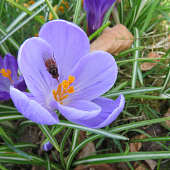By managing the field margins in a different way - by using a richer vegetation - the pest pressure for farmers in arable farming has been reduced. The richer vegetation provides shelter for natural enemies of pests and insects. This principle can also be applied in the fight against the oak processionary moth.
Specific wildflowers, but also bulb varieties have been selected to stimulate natural enemies of the oak processionary moth. These mixtures have various characteristics. The wildflower mixtures consist partly of native varieties grown and harvested in Great Britain. Naturalising bulbs are used in the mixture. These flower very early in spring and form a welcome nectar and pollen source for the first insects.
As you can see in the photos on the left, a number of examples of, among other things, parasitic wasps- and flies and sand bees on the various bulbs.
In addition, a large number of umbellate and leguminous varieties are included in the mixtures. These varieties also form a food source for the natural enemies. In combination with nesting sites, a suitable habitat can be created. Finally, the mixtures are area specific as much as possible. The exact mixture is determined on the basis of the local conditions: the location of the site, soil and moisture conditions and sun/shade conditions.
Specific wildflowers, but also bulb varieties have been selected to stimulate natural enemies of the oak processionary moth. These mixtures have various characteristics. The wildflower mixtures consist partly of native varieties grown and harvested in Great Britain. Naturalising bulbs are used in the mixture. These flower very early in spring and form a welcome nectar and pollen source for the first insects.
As you can see in the photos on the left, a number of examples of, among other things, parasitic wasps- and flies and sand bees on the various bulbs.
In addition, a large number of umbellate and leguminous varieties are included in the mixtures. These varieties also form a food source for the natural enemies. In combination with nesting sites, a suitable habitat can be created. Finally, the mixtures are area specific as much as possible. The exact mixture is determined on the basis of the local conditions: the location of the site, soil and moisture conditions and sun/shade conditions.






